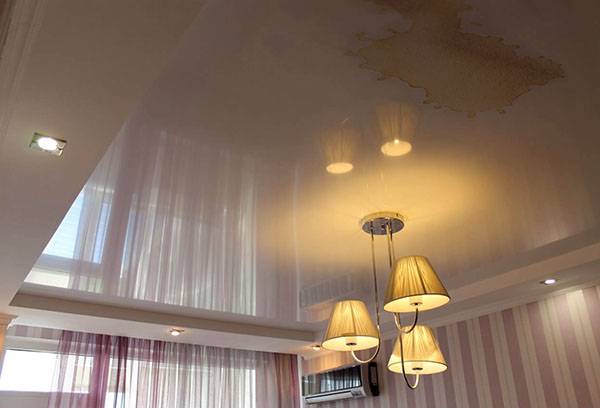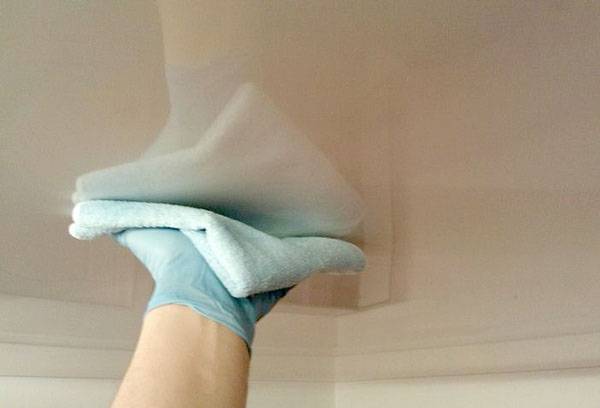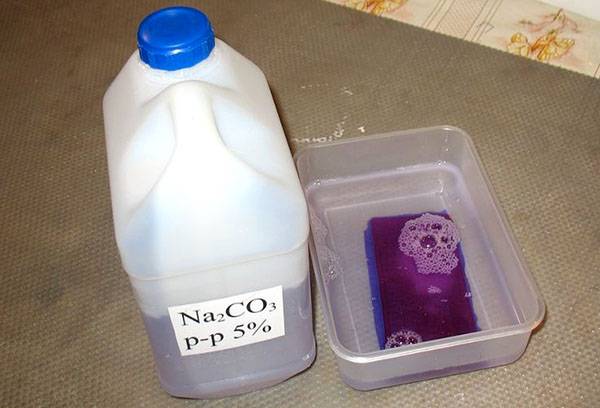What is the easiest way to remove stains from the surface of a stretch ceiling?
Every owner of suspended ceilings at least once in his life has encountered the need to clean them. Stains on a suspended ceiling appear for various reasons, which you need to be aware of and, at the first signs, eliminate either the source or existing stains.
Before installing modern suspended ceilings, many are mistaken, assuming that they are located quite far from all influences, and therefore rarely succumb to contamination. But this is not true at all. Moreover, owners of fabric tension surfaces should remember that most often they are the ones that get dirty.
But don’t get upset and make rash decisions when you see stains. In order to know how to wash them correctly, you must first understand why they appeared. After all, certain cleaning products and tools are selected based on the cause of the problem. This especially applies to fabric stretch ceilings.

The most common causes of stains on stretch ceilings
Manufacturers apply a special protective layer to cover all tension surfaces, which prevents the spread of microbes, various fungi and mold. But it is impossible to insure any ceiling against mechanical damage. Let's look at the most common causes of stains on stretch ceilings.
- Splashes of grease and soot.
Soot and grease deposits appear on the surfaces located in the kitchen.
- Moisture.
After moisture enters and dries, characteristic stains remain on the ceiling.If you live in a private house or in a multi-story house on the top floor, the roof may often leak. Roof leaks cause yellow spots to appear. Also, characteristic stains appear on bathroom ceilings from accumulating moisture or splashes from washing, for example, in the shower. Also, yellow spots appear after neighbors flood the apartment. And even when the ceiling is washed, stains may appear again if the interfloor slab is not completely dry after pouring.
- Dye.
Paint can affect suspended ceilings in several ways. For example, if there are metal pipes in the ceiling that need to be constantly painted. Then the stains appear from the splashes of the brush. Or the previous ceiling finish could have been painted over with oil paint. This happens quite often, because previously it was believed that oil paints looked beautiful and were quite durable. The oil that remains even after complete removal of paint penetrates deep into the floor slab and appears gradually over time.
- Dust, including construction dust.
Especially a lot of dust is generated when drilling brick or concrete walls.
- Rust.
It appears if the house is already quite old. Rust forms gradually and significantly spoils the appearance of the surface. Often red stains appear after neighbors have flooded the ceiling.
How to remove various types of stains from a stretch ceiling?
Contaminants of different types also need to be removed in different ways. Some things can be easily erased, while others can be removed only after drastic actions. But still, the easiest way to remove stains is from moisture, be it stains after swimming in the shower, from an exploding jar of compote, or even if after swatting away a mosquito and there are traces of blood on the ceiling.All this must be carefully wiped off with a damp cloth. You can use a slightly damp, lint-free cloth. It’s just as easy to remove marks on a glossy ceiling or a fabric one.
Dealing with stains after a long accumulation of moisture or flooding is not much more difficult. The moisture accumulated in it will protect the entire interior from unplanned repairs, but the ceiling itself will be damaged.
It is necessary to apply a little greasy clay or a solution of soda ash to the damaged areas of the ceiling. After the product dries, it must be washed off with plain clean water. If only part of the dirt is removed, the procedure must be repeated. This method can also help in case of rust.
Soot and grease stains can be removed with a simple soap solution.
- You need to crumble a small piece of soap into shavings and add it to warm water.
- You can also add a little mild washing powder to the water.
- The soap and powder should be completely dissolved. It is very important. Otherwise, the surface may be damaged or scratched.
- It is necessary to wipe the protocol with a soft cloth, again preferably without lint.
Advice
When working, the canvas can be damaged by rings and bracelets on your hands - it is better to remove them. Be sure to wipe with your hands, do not use a mop, otherwise you may scratch the fabric. Wash until the ceiling is clean.
Any dust, even construction dust, can be removed with a vacuum cleaner. The nozzle must be used with long bristles. There is no need to rub with a washcloth, napkin or cloth, otherwise streaks may remain. In addition, the dust may contain large particles that will scratch the canvas.
In the case of paint, you can use several methods, starting with a soap solution.If soap with powder does not help, you can use ammonia. Dissolve a little product in water and wipe the surface.
If you have a fabric stretch ceiling, you can wash off the dirt with soda.
- It is necessary to prepare a 5% solution of soda ash.
- You can add a little salt to the water. This will improve cleansing.
- The entire solution must be stirred well so that not even small scratching particles remain.
You can also wipe with a simple cloth until the stains go away.
You can also use special products to wash suspended ceilings. Such compositions are much more expensive than the above methods. They are produced in several types:
- sprays;
- gels;
- liquid solutions.
Therefore, when stains appear, do not panic. Any stain can be cleaned. The main thing is to do it properly.


How to clean blue stains from suspended ceilings?
Please advise